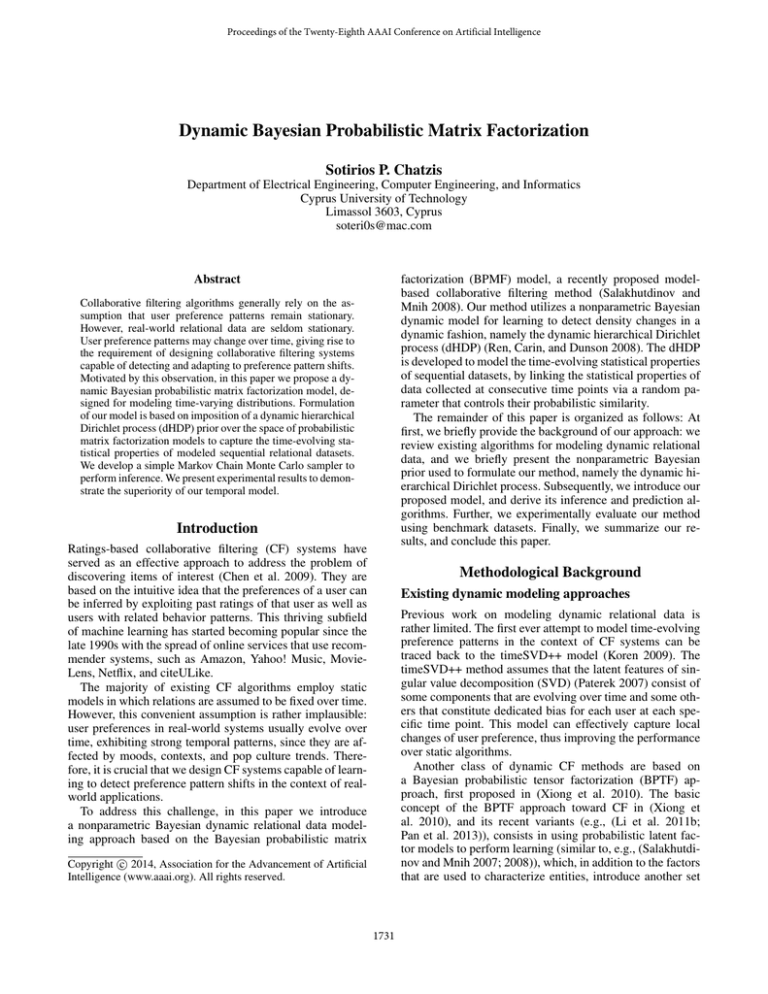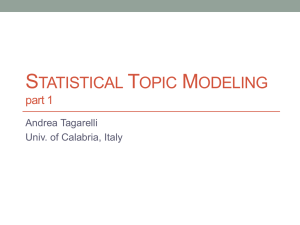
Proceedings of the Twenty-Eighth AAAI Conference on Artificial Intelligence
Dynamic Bayesian Probabilistic Matrix Factorization
Sotirios P. Chatzis
Department of Electrical Engineering, Computer Engineering, and Informatics
Cyprus University of Technology
Limassol 3603, Cyprus
soteri0s@mac.com
Abstract
factorization (BPMF) model, a recently proposed modelbased collaborative filtering method (Salakhutdinov and
Mnih 2008). Our method utilizes a nonparametric Bayesian
dynamic model for learning to detect density changes in a
dynamic fashion, namely the dynamic hierarchical Dirichlet
process (dHDP) (Ren, Carin, and Dunson 2008). The dHDP
is developed to model the time-evolving statistical properties
of sequential datasets, by linking the statistical properties of
data collected at consecutive time points via a random parameter that controls their probabilistic similarity.
The remainder of this paper is organized as follows: At
first, we briefly provide the background of our approach: we
review existing algorithms for modeling dynamic relational
data, and we briefly present the nonparametric Bayesian
prior used to formulate our method, namely the dynamic hierarchical Dirichlet process. Subsequently, we introduce our
proposed model, and derive its inference and prediction algorithms. Further, we experimentally evaluate our method
using benchmark datasets. Finally, we summarize our results, and conclude this paper.
Collaborative filtering algorithms generally rely on the assumption that user preference patterns remain stationary.
However, real-world relational data are seldom stationary.
User preference patterns may change over time, giving rise to
the requirement of designing collaborative filtering systems
capable of detecting and adapting to preference pattern shifts.
Motivated by this observation, in this paper we propose a dynamic Bayesian probabilistic matrix factorization model, designed for modeling time-varying distributions. Formulation
of our model is based on imposition of a dynamic hierarchical
Dirichlet process (dHDP) prior over the space of probabilistic
matrix factorization models to capture the time-evolving statistical properties of modeled sequential relational datasets.
We develop a simple Markov Chain Monte Carlo sampler to
perform inference. We present experimental results to demonstrate the superiority of our temporal model.
Introduction
Ratings-based collaborative filtering (CF) systems have
served as an effective approach to address the problem of
discovering items of interest (Chen et al. 2009). They are
based on the intuitive idea that the preferences of a user can
be inferred by exploiting past ratings of that user as well as
users with related behavior patterns. This thriving subfield
of machine learning has started becoming popular since the
late 1990s with the spread of online services that use recommender systems, such as Amazon, Yahoo! Music, MovieLens, Netflix, and citeULike.
The majority of existing CF algorithms employ static
models in which relations are assumed to be fixed over time.
However, this convenient assumption is rather implausible:
user preferences in real-world systems usually evolve over
time, exhibiting strong temporal patterns, since they are affected by moods, contexts, and pop culture trends. Therefore, it is crucial that we design CF systems capable of learning to detect preference pattern shifts in the context of realworld applications.
To address this challenge, in this paper we introduce
a nonparametric Bayesian dynamic relational data modeling approach based on the Bayesian probabilistic matrix
Methodological Background
Existing dynamic modeling approaches
Previous work on modeling dynamic relational data is
rather limited. The first ever attempt to model time-evolving
preference patterns in the context of CF systems can be
traced back to the timeSVD++ model (Koren 2009). The
timeSVD++ method assumes that the latent features of singular value decomposition (SVD) (Paterek 2007) consist of
some components that are evolving over time and some others that constitute dedicated bias for each user at each specific time point. This model can effectively capture local
changes of user preference, thus improving the performance
over static algorithms.
Another class of dynamic CF methods are based on
a Bayesian probabilistic tensor factorization (BPTF) approach, first proposed in (Xiong et al. 2010). The basic
concept of the BPTF approach toward CF in (Xiong et
al. 2010), and its recent variants (e.g., (Li et al. 2011b;
Pan et al. 2013)), consists in using probabilistic latent factor models to perform learning (similar to, e.g., (Salakhutdinov and Mnih 2007; 2008)), which, in addition to the factors
that are used to characterize entities, introduce another set
c 2014, Association for the Advancement of Artificial
Copyright Intelligence (www.aaai.org). All rights reserved.
1731
of latent features for each different time period. Intuitively,
these additional factors represent the population-level preference of latent features at each particular time, capturing
preference changes due to, e.g., mood variation, change of
context, or different pop culture trends. Model formulation
is based on CANDECOMP/PARAFAC (CP) decomposition
(Kolda and Bader 2009) or Tucker decomposition (Tucker
1966), which generalize matrix SVD to tensors.
Finally, another interesting approach is the recently proposed RMGM-OT method of (Li et al. 2011a). This method
uses Bi-LDA, a Bayesian latent factor model for matrix trifactorization (Porteous, Bart, and Welling 2008), to model
user-interest drift in the context of CF systems. This method
outperformed timeSVD++ in the Netflix dataset.
(Teh et al. 2005) proposed a hierarchical Dirichlet process
(HDP) model that allows for linking a set of group-specific
Dirichlet processes, learning the model components jointly
across multiple groups of data. Specifically, let us assume
J groups of data; let the dataset from the jth group be deNj
noted as {xji }i=1
. An HDP-based model considers that the
data from each group are drawn from a distribution with difNj
ferent parameters {θ ∗ji }i=1
, which are in turn drawn from
group-specific DPs. In addition, HDP assumes that the base
distribution of the group-specific DPs is a common underlying DP. Under this construction, the generative model for
the HDP yields
xji ∼ F (θ ∗ji )
(6)
The dynamic hierarchical Dirichlet process
Dirichlet process (DP) models were first introduced by Ferguson (Ferguson 1973). A DP is characterized by a base distribution G0 and a positive scalar α, usually referred to as
the innovation parameter, and is denoted as DP(α, G0 ). Let
us suppose we randomly draw a sample distribution G from
a DP, and, subsequently, we independently draw M random
variables {θ ∗m }M
m=1 from G:
G|α, G0 ∼ DP(α, G0 )
θ ∗m |G ∼ G,
m = 1, . . . M
(1)
(2)
∈ [0, 1]
P∞
c=1
G0 ∼ DP(γ, H)
(9)
Hj−1 ∼ DP(αj , G0 )
(10)
(11)
and the weights w̃j−1 are Beta-distributed variables:
w̃j−1 ∼ Beta(aj−1 , bj−1 )
(12)
Under this construction, the distribution pertaining to the
jth dataset, Gj , deviates from the distribution pertaining to
the previous dataset, Gj−1 , by introducing a new innovation
distribution Hj−1 , and the Beta-distributed random variable
w̃j−1 that controls the probability of innovation. As a result
(5)
j=1
and
(8)
and G1 ∼ DP(α1 , G0 ), where G0 is a discrete distribution
drawn as given by (9), similar to the HDP model, Hj−1 is
called the innovation distribution, and is drawn as
where δθc denotes the distribution concentrated at a single
point θ c ,
p(vc ) = Beta(1, α)
(4)
(1 − vj )
Gj ∼ DP(αj , G0 )
Gj ∼ (1 − w̃j−1 )Gj−1 + w̃j−1 Hj−1 , j > 1
c=1
$c (v) = vc
(7)
where j = 1, . . . , J, and i = 1, . . . , Nj .
In the context of the HDP, different observations that belong to the same group share the same parameters (atoms)
that comprise Gj . In addition, observations across different
groups might also share parameters (atoms), probably with
different mixing probabilities for each DP Gj ; this is a consequence of the fact that the DPs Gj pertaining to all the
modeled groups share a common base measure G0 , which is
also a discrete distribution.
Although the HDP introduces a dependency structure
over the modeled groups, it does not account for the fact that,
when it comes to modeling of sequential data, especially
data the distribution of which changes over time, sharing
of underlying atoms from the DPs is more probable among
datasets collected closely in time. To allow for such a modeling capacity, a dynamic variant of the hierarchical Dirichlet process has been proposed in (Ren, Carin, and Dunson
2008).
Let us assume J datasets collected sequentially in time,
N2
1
i.e., {x1i }N
i=1 is collected first, {x2i }i=1 is collected second, and so on. To introduce the assumption that datasets
collected at adjacent time points are more likely to share underlying patterns, and, hence, the same atoms, (Ren, Carin,
and Dunson 2008) proposed the dHDP model, which postulates
Integrating out G, the joint distribution of the variables
{θ ∗m }M
m=1 can be shown to exhibit a clustering effect.
−1
Specifically, given the first M − 1 samples of G, {θ ∗m }M
m=1 ,
∗
it can be shown that a new sample θ M is either (a) drawn
α
from the base distribution G0 with probability α+M
−1 ,
or (b) is selected from the existing draws, according to a
multinomial allocation, with probabilities proportional to
the number of the previous draws with the same allocation
(Blackwell and MacQueen 1973).
Let {θ c }C
c=1 be the set of distinct values taken by the vari−1
ables {θ ∗m }M
m=1 . A characterization of the (unconditional)
distribution of the random variable G drawn from a DP,
DP(α, G0 ), is provided by the stick-breaking construction
of Sethuraman (Sethuraman 1994). Consider two infinite
∞
collections of independent random variables v = [vc ]c=1 ,
∞
{θ c }c=1 , where the vc are drawn from a Beta distribution,
and the θ c are independently drawn from the base distribution G0 . The stick-breaking representation of G is then given
by
∞
X
G=
$c (v)δθc
(3)
c−1
Y
θ ∗ji ∼ Gj
$c (v) = 1.
1732
of this construction, the model encourages sharing between
temporally proximate data.
Denoting as π j the weights of the set of the atoms drawn
from the innovation distribution Hj−1 , and introducing the
atom indicator variables {zji }j,i , and the auxiliary innovation distribution selection latent variables {φji }j,i , dHDP
can be also expressed under the following alternative construction:
xji |zji = k; {θ k }∞
k=1 ∼ F (θ k )
(13)
zji |φji ; {π h }jh=1 ∼ Mult(π φji )
(14)
π j ∼ DP(αj , G0 )
(15)
G0 ∼ DP(γ, H)
φji |w̃ ∼ Mult(wj )
with wj =
(wjl )jl=1 ,
the users belonging to the same group are generated from
the same underlying distribution.
Following the assumptions of the imposed dHDP, we subsequently have
zit |φti ; {π τ }tτ =1 ∼ Mult(π φti )
π τ = (πτ l )∞
l=1 , where, following (Teh et al. 2005), we have
πtl = π̃tl
wjl = w̃l−1
(1 − π̃th )
π̃tl ∼ Beta(αt βl , αt (1 −
(16)
(23)
l
X
βm ))
(24)
m=1
(17)
βk = $k
k−1
Y
(1 − $q )
(25)
q=1
(1 − w̃m ), l = 1, . . . , j
(18)
$k ∼ Beta(1, γ)
m=l
w̃j |aj , bj ∼ Beta(w̃j |aj , bj ), j = 1. . . . , J − 1
φti |w̃ ∼ Mult(wt )
(19)
(27)
with wt = (wtl )tl=1 ,
Proposed Approach
t
Let us consider we are given a set of rankings R = {rij
}i,j,t
assigned by a set of users with indices i ∈ {1, . . . , N } to a
set of items with indices j ∈ {1, . . . , M } at different time
slices, t ∈ {1, . . . , T }. Let us also consider that the preference patterns of the users may change over time (at different
time slices), due to different moods, contexts, or pop culture
trends. In addition, we assume that user preferences actually exhibit strong temporal patterns, thus tending to evolve
gradually over time. To obtain a model-based CF method capable of incorporating these assumptions into its inference
and prediction mechanisms, we proceed as follows.
t N,M
Let us denote as Rt = {rij
}i,j=1 , the set of rankings obtained at time slice t ∈ {1, . . . , T }. We consider
M
N Y
Y
t t
I t
p(rij |U , V ; σ 2 ) ij
(26)
and the latent (innovation distribution selection) variables φti
of the dHDP yield
while w̃0 = 1, and
p(Rt |U t , V ; σ 2 ) =
l−1
Y
h=1
and
j−1
Y
(22)
t−1
Y
(1 − w̃m ), l = 1, . . . , t
(28)
w̃t |at , bt ∼ Beta(w̃t |a, b), t = 1. . . . , T − 1
(29)
wtl = w̃l−1
m=l
and w̃0 = 1. Finally, we also consider
p(uki |µkU , ΛkU ) = N (uki |µkU , [ΛkU ]−1 )
(30)
p(v i |µV , ΛV ) = N (v i |µV , Λ−1
V )
(31)
with
(20)
p(µkU , ΛkU ) = N W(µkU , ΛkU |λU , mU , ηU , S U )
(32)
p(µV , ΛV ) = N W(µV , ΛV |λV , mV , ηV , S V )
(33)
similar to the standard BPMF model.
This concludes the formulation of our model. We dub our
approach the dynamic BPMF (dBPMF) model. Inference for
our model can be efficiently performed by means of MCMC.
i=1 j=1
t
where Iij
is an indicator variable equal to 1 if the ith user
rated the jth item at time slice t, 0 otherwise, and U t is the
set of user latent feature vectors at the time slice t. To introduce temporal dynamics into the model, and capture the
evolution of the latent feature vectors of the users over time,
we impose a dHDP prior over the user latent feature vectors,
yielding
t
rij
| zit = k ∼ N (uki · v j , σ 2 )
(21)
Inference algorithm
To efficiently perform inference for the dBPMF model, we
devise a variant of the block Gibbs sampler in (Ishwaran and
James 2001). To make inference tractable, we use a truncated expression of the stick-breaking representation of the
underlying shared DP of our model, G0 . In other words, we
set a truncation threshold C, and consider π t = (πtl )C
l=1 , ∀t
(Ishwaran and James 2001). A large value of C allows
for obtaining a good approximation of the infinite stickbreaking process, since in practice the πtl are expected to
diminish quickly with increasing l, ∀t (Ishwaran and James
2001).
where uki is the latent feature vector of the ith user, if we
consider that user i belongs at time t to the kth group of
users, i.e. zit = k. In other words, to model the transitive
dynamics of user preference patterns, we consider that each
user belongs at each time slice to some user group, users
change groups over time, and the latent feature vectors of
1733
λ̃kU = λU + N
k
η̃U
= ηU + N
P
N
1
k
and, denoting ū = N i=1 uki we have
Let us begin with the expression of the conditional distribution of w̃t , for t = 1, . . . , T − 1; we have
p(w̃t | . . . ) = Beta(w̃t |a +
T
X
nj,t+1 , b +
j=t+1
T
t
X
X
njh )
N
X
k −1
T
−1
S̃ U
= SU +
uki − ūk uki − ūk
j=t+1 h=1
(34)
PN
t
where nth =
i=1 δ(φi = h), and δ(·) is the Kronecker
delta function. Similar, the conditional posterior of π̃tl , l =
1, . . . , C, yields
p(π̃tl | . . . ) = Beta π̃tl |αt βl +
T X
N
X
l
X
βm ) +
m=1
δ(φji = t)δ(zij = l),
p(v j | . . . ) = N (v j |µ∗j , [Λ∗j ]−1 )
δ(φji = t)δ(zij = k)
Λ∗j = ΛV +
j=1 i=1 k=l+1
(35)
(1 − w̃m )π̃τ zit
m=τ
×
M Y
and
µ∗j =[Λ∗j ]−1
!
T
C N
t
1 XXX
t
k t Iij
δ(zi = k)[ui rij ]
× ΛV µV + 2
σ t=1
k=1 i=1
(48)
with the conditional posteriors of the corresponding model
hyperparameters yielding
zit −1
Y
(1 − π̃τ q )
q=1
t
Iij
zt
t
N (rij
|ui i · v j , σ 2 )
, τ = 1, . . . , t
j=1
p(µV , ΛV | . . . ) = N W(µV , ΛV |λ̃V , m̃V , η̃V , S̃ V )
where
PM
λV mV + j=1 v j
m̃V =
λV + M
λ̃V = λV + M
η̃V = ηV + M
PM
1
and, denoting v̄ = M j=1 v j , we have
(36)
Similar, the set of indicator variables {zit }N,T
are
obtained
i,t=1
by generating samples from multinomial distributions with
entries of the form
p(zit = k| . . . ) ∝ π̃φti k
k−1
Y
(1 − π̃φti q )
q=1
×
M
Y
t
N (rij
|uki
(37)
2
· vj , σ )
t
Iij
T
C N
t
1 XXX
δ(zit = k)[uki (uki )T ]Iij (47)
σ 2 t=1
i=1
k=1
The updates of the set of indicator variables {φti }N,T
i,t=1 can
be obtained by generating samples from multinomial distributions with entries of the form
p(φti = τ | . . . ) ∝w̃τ −1
(46)
where
T X
N
C
X
X
t−1
Y
(45)
i=1
T
λU N
mU − ūk mU − ūk
+
λU + N
Finally, the latent factor vectors of the items, v j , yield
j=1 i=1
αt (1 −
(43)
(44)
, k = 1, . . . , C
h
j=1
S̃ V
i−1
=S −1
V +
M
X
p(uki | . . . ) = N (uki |µki , [Λki ]−1 )
(50)
(51)
(52)
T
(v j − v̄) (v j − v̄)
(53)
j=1
The time-evolving latent factor vectors of the users, uki , read
(49)
λV M
T
(mV − v̄) (mV − v̄)
+
λV + M
(38)
Prediction
where
Λki = ΛkU +
T
M
X
t
1 X
t
δ(z
=
k)
[v j v Tj ]Iij
i
2
σ t=1
j=1
Having derived the inference algorithm of our model, we
now proceed to derivation of its prediction algorithm. This
consists in using the trained model to estimate the unknown
rating a user with index i ∈ {1, . . . , N } would have assigned
to an item with index j ∈ {1, . . . , M } at some time slice
t ∈ {1, . . . , T }, if they had rated it at that time slice. For
this purpose, we resort to an MCMC-based approximation:
We use block Gibbs sampling to generate multiple samples
from the posterior distributions over the model parameters
and hyperparameters. Using these samples, the generated
prediction is approximated as
(39)
and
T
M
X
X
t
1
t Iij
µki = [Λki ]−1 ΛkU µkU + 2
δ(zit = k)
[v j rij
]
σ t=1
j=1
(40)
with the conditional posteriors of the corresponding model
hyperparameters yielding
Ξ
k
t
r̂ij
≈
k
p(µkU , ΛkU | . . . ) = N W(µkU , ΛkU |λ̃kU , m̃kU , η̃U
, S̃ U ) (41)
1 X (ξ) (ξ)
ui · v j
Ξ
(54)
ξ=1
where
m̃kU =
PN
λU mU + i=1 uki
λU + N
where Ξ is the number of drawn samples, and [·](ξ) is the ξth
drawn sample.
(42)
1734
months together so that every time slice contains an approximately equal number of ratings. This way, we eventually
yield 27 time slices for the entire dataset.
We perform experiments on a subset of the Netflix data
constructed by randomly selecting 20% of the users and 20%
of the movies, similar to (Xiong et al. 2010). From the resulting dataset, we randomly select 30% of the ratings, and no
more than 10 ratings in any case, from each user as the test
set, and use the rest for training. This procedure is similar
to the way Netflix Prize created their test set. We perform
10-fold cross-validation to alleviate the effects of random
selection of training and test samples on the obtained performance measurements.
3.4885
3.2723
2.9723
2.6723
2.3723
RMSE
2.0723
1.7723
1.5723
1.3723
1.2723
1.1723
1.0723
0.9723
0.8723
1 10 20 30 40
60
80
100 120 140
Number of Samples
160
180
200
Figure 2: dBPMF convergence.
Results
In Fig. 1a, we illustrate how performance changes for the
BPMF, BPTF, and dBPMF models by varying the number
of latent features. These results are averages (mean RMSE)
over the conducted 10 folds of our experiment. As we observe, in general, all models yield an RMSE decrease as the
number of factors increases. We also note that increasing the
latent features to more than 50 does not result in substantial further performance improvements for the dynamic data
modeling methods; in contrast, BPMF performance continues to yield some improvement. This fact indicates that the
lack of temporal structure extraction mechanisms in the context of static models results in them relying on the derived
latent subspace representations to make up for this inadequacy.
In Fig. 1b, we also illustrate in detail the performances of
all the evaluated algorithms for optimal latent space dimensionality (wherever applicable), as determined from the previous illustration, in the form of box plots. As we observe,
our algorithm works better than the competition, including
the related BPTF method. Specifically, our method outperforms BPTF both in terms of median performance, and the
25th and 75th percentiles of the set of the obtained performances. Further, we observe that RMGM-OT obtains a statistically significant improvement over the other methods,
being the second best performing method. However, it remains inferior to dBPMF.
Finally, to confirm the statistical significance of our findings, we run the Student’s-t test on the pairs of performances
(for optimal numbers of latent features) of our method and
all its considered competitors. As we observe, the Student’st test yields p-values ranging from 0.47 ∗ 10−16 , obtained
when we compare our method to RMGM-OT, to 0.1∗10−16 ,
obtained when we compare to BPMF. Given that p-values
below 10−2 indicate statistically significant differences, we
deduce that our results are strongly statistically significant
in all cases.
Experimental Evaluation
To assess the efficacy of our approach, we experiment with
the Netflix dataset1 . This dataset comprises users ratings
to various movies, given on a 5-star scale. To obtain some
comparative results, we also evaluate recently proposed dynamic relational data modeling approaches, namely the tensor factorization-based BPTF method (Xiong et al. 2010),
and the Bi-LDA-based RMGM-OT method (Li et al. 2011a).
We also compare to a related state-of-the-art static modeling
method, namely BPMF (Salakhutdinov and Mnih 2008). We
run our experiments as a single-threaded MATLAB process
on a 2.53 GHz Intel Core 2 Duo CPU. In our experiments,
we use source code provided by the authors of the BPTF
(Xiong et al. 2010) and RMGM-OT (Li et al. 2011a) papers.
For all models, prediction results are clipped to fit in the
interval [1, 5]. BPMF is initialized with λU = λV = 1,
mU = mV = 0, ηU = ηV = 30, S U = S V = I, similar
to (Salakhutdinov and Mnih 2008). Similar hyperparameter
values are selected for our model, to ensure fairness in our
comparisons. For the RMGM-OT method, we heuristically
determined that using 20 user and item groups, as also suggested in (Li et al. 2011a), and preset in the source code provided by the authors, yields optimal results. Finally, for the
BPTF method, hyperparameter selection is based on the suggestions of (Xiong et al. 2010). Convergence of the Gibbs
sampler (wherever applicable) is diagnosed by monitoring
the behavior of the Frobenius norms of the sampled model
parameters and hyperparameters. Performance is evaluated
on the grounds of the root mean square error (RMSE) metric, a standard evaluation metric in CF literature.
Experimental Setup
Netflix dataset contains 100, 480, 507 ratings from N =
480, 189 users to M = 17, 770 movies rated between 1999
and 2005. Apart from the training set, the Netflix dataset
also provides a probe set which comprises 1, 408, 395 uniformly selected users. Time information is provided in days.
The timestamps we use in our experiments correspond to
calendar months. However, the ratings in the early months
are much more scarce than the later months. For this reason,
similar to (Xiong et al. 2010), we aggregate several earlier
1
Further investigation
Following the definition of our model and the provided
encouraging experimental results, a question that naturally
arises is whether the observed advantages of our approach
do actually stem from the dynamic nature of the clustering
mechanism of the dHDP prior, or application of a simpler
clustering mechanism could also yield similar benefits in
http://archive.ics.uci.edu/ml/datasets/Netflix+Prize
1735
0.884
BPMF
DP−based model
HDP−based model
BPTF
dBPMF
0.882
0.8732
0.873
0.88
0.8728
0.8726
RMSE
RMSE
0.878
0.8724
0.876
0.8722
0.874
0.872
0.8718
0.872
0.87
10
BPMF
50
100
150
200
Number of Latent Dimensions
250
DP−based
HDP−based
BPTF
RMGM−OT
dBPMF
300
(a)
(b)
Figure 1: Netflix dataset: (a) Performance fluctuation as a function of latent dimensionality. (b) Box plot of the obtained RMSEs
for optimal number of latent features.
terms of the obtained predictive performance. Indeed, based
on the properties of the dHDP (Ren, Carin, and Dunson
2008), if we set w̃j = 0, ∀j, we straightforwardly obtain that
our dHDP-based model reduces to a simple Dirichlet process mixture model, while if we set w̃j = 1, ∀j, our model
reduces to a simpler HDP-based model. Such model variants
do also entail parameter sharing, but not in a temporally coherent manner. Therefore, a question that naturally arises is:
How would a DP- or HDP-based model perform compared
to the full dHDP-based model proposed in this work?
To answer this question, we repeat our previous experiments, setting w̃j = 0, ∀j, and w̃j = 1, ∀j, respectively,
for varying numbers of latent features. The obtained results are also provided in Figs. 1a and 1b (lines “DP-based
model,” and “HDP-based model,” respectively). As we observe, the performance of these reduced versions of our
model (lacking temporal dynamics in their parameter sharing mechanisms), is much inferior to the performance of our
full-fledged method. Indeed, it seems that for w̃j = 0, ∀j,
i.e. considering a DP-based reduced version of our model,
we yield performance almost identical to BPMF, while for
w̃j = 1, ∀j, i.e. considering an HDP-based variant of our
model, performance is better than BPMF only in cases of
low latent space dimensionality, and always inferior to dynamic methods. Therefore, retaining the full functionality of
the dHDP, and, hence, extracting the temporal dynamics in
the modeled data, is crucial for model performance.
Finally, in Fig. 2 we illustrate the convergence of our algorithm as a function of the number of drawn samples. We
observe that our algorithm starts from a bad model estimate,
due to its random initialization, but converges in a fast pace.
minutes and 5GB RAM. In comparison, in our unoptimized
MATLAB implementation, our method required about 9
minutes time and 5GB RAM. Turning to prediction generation, which is what actually matters in a real-world system,
once the required number of model samples are obtained and
stored, our model can generate predictions instantaneously,
with no time overhead compared to the competition.
Conclusions
In this work, we presented a nonparametric Bayesian approach for modeling relational data the distributions of
which evolve in a dynamic fashion. Formulation of our
method is based on an extension of the probabilistic matrix
factorization framework under a Bayesian model treatment.
To allow for effectively capturing preference pattern shifts
in a dynamic fashion, we imposed a dynamic hierarchical
Dirichlet process prior over the latent feature vectors of the
users. We evaluated our method using the Netflix datasets.
We observed that our method both outperforms existing dynamic relational data modeling methods, as well as state-ofthe-art static modeling approaches, without scalability sacrifices.
As we explained, our method reduces to simpler DP- or
HDP-based models, i.e., models that do not entail temporal
dynamics, by setting w̃j = 0, ∀j, and w̃j = 1, ∀j, respectively. As we showed, under such a setup, the obtained performance is significantly inferior to the full dBPMF model.
Therefore, we deduce that the advantages of our model are a
result of its dynamic nature, and could not be obtained by alternative clustering-based models that do not entail temporal
dynamics in their clustering mechanisms.
Our future goal is to explore more efficient inference algorithms for our model under a deterministic framework,
e.g., variational Bayes (Blei and Jordan 2006; Wang and Blei
2012) or expectation-propagation (Minka 2001).
Computational complexity
To conclude, we provide an indicative comparison of computational costs. As we observed, generation of one sample from the BPMF model required less than 6 minutes time
and 4GB RAM, while BPTF and RMGM-OT took about 8
1736
References
Xiong, L.; Chen, X.; Huang, T.-K.; Schneider, J.; and Carbonell, J. G. 2010. Temporal collaborative filtering with
Bayesian probabilistic tensor factorization. In Proc. SDM.
Blackwell, D., and MacQueen, J. 1973. Ferguson distributions via Pólya urn schemes. The Annals of Statistics
1(2):353–355.
Blei, D. M., and Jordan, M. I. 2006. Variational inference
for Dirichlet process mixtures. Bayesian Analysis 1(1):121–
144.
Chen, W. Y.; Chu, J. C.; Luan, J.; Bai, H.; Wang, Y.; and
Chang, E. Y. 2009. Collaborative filtering for Orkut communities: discovery of user latent behavior. In Proc. WWW’09,
681–690.
Ferguson, T. 1973. A Bayesian analysis of some nonparametric problems. The Annals of Statistics 1:209–230.
Ishwaran, H., and James, L. F. 2001. Gibbs sampling methods for stick-breaking priors. Journal of the American Statistical Association 96:161–173.
Kolda, T. G., and Bader, B. W. 2009. Tensor decompositions
and applications. SIAM Review 51(3):455–500.
Koren, Y. 2009. Collaborative filtering with temporal dynamics. In Proc. KDD-09.
Li, B.; Zhu, X.; Li, R.; Zhang, C.; Xue, X.; and Wu, X.
2011a. Cross-domain collaborative filtering over time. In
Proc. 22nd AAAI, 2293–2298.
Li, R.; Li, B.; Jin, C.; Xue, X.; and Zhu, X. 2011b. Tracking
user-preference varying speed in collaborative filtering. In
Proc. 25th AAAI.
Minka, T. 2001. Expectation Propagation for Approximate
Bayesian Inference. In Proc. UAI.
Pan, J.; Ma, Z.; Pang, Y.; and Yuan, Y. 2013. Robust probabilistic tensor analysis for time-variant collaborative filtering. Neurocomputing 119(7):139 – 143.
Paterek, A. 2007. Improving regularized singular value decomposition for collaborative filtering. In In KDDCup ’07.
Porteous, I.; Bart, E.; and Welling, M. 2008. Multi-HDP: A
non parametric bayesian model for tensor factorization. In
Proc. 23rd National Conf. on Artificial Intelligence, 1487–
1490.
Ren, L.; Carin, L.; and Dunson, D. B. 2008. The dynamic
hierarchical Dirichlet process. In Proc. International Conference on Machine Learning (ICML).
Salakhutdinov, R., and Mnih, A. 2007. Probabilistic matrix
factorization. In Proc. NIPS.
Salakhutdinov, R., and Mnih, A. 2008. Bayesian probabilistic matrix factorization using Markov chain monte carlo. In
Proc. ICML’08.
Sethuraman, J. 1994. A constructive definition of the Dirichlet prior. Statistica Sinica 2:639–650.
Teh, Y. W.; Jordan, M. I.; Beal, M. J.; and Blei, D. M. 2005.
Hierarchical Dirichlet processes. Technical report, Dept. of
Computer Science, National University of Singapore.
Tucker, L. R. 1966. Some mathematical notes on threemode factor analysis. Psychometrika 31(3):279–311.
Wang, C., and Blei, D. M. 2012. Truncation-free Stochastic
Variational Inference for Bayesian Nonparametric Models.
In Pro. NIPS.
1737







